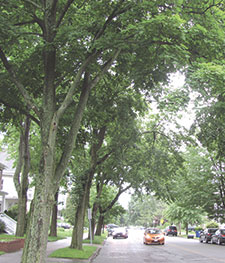
The Urban Forestry Committee recently hosted a meeting informing the public about its latest efforts in managing the city’s green spaces.
By Luda Tang
The Urban Forestry Committee hosted a virtual meeting on Thursday, July 21, which discussed some concerns from residents and presented several updates of the on-going projects.
Committee members started the conversation by sharing the possibility of the emergence of one invasive insect in the city of Somerville, which is the spotted lanternflies. They attack trees like the tree-of-heaven variety. In the early stage, lanternflies are black and small, and become red with white as they grow. A small population of lanternflies were detected in Worcester County last year.
Residents also raised the concern about if trees get watered. Vanessa Boukili, the Senior Urban Forestry and Landscape Planner in the city of Somerville, explained that when trees are planted, they have a two-year watering program associated with them. The current contractor is obligated to fill out the gator bag twice a week for the first thirty days and once a week after that to water the tree. City staff will also inspect trees that were pointed out by residents that looked lifeless.
Several on-going projects have made some progress, including the Adopt-A-Tree program in the community. This program was initiated to help The Urban Forestry Committee to take care of the newly planted trees by watering and learning how to inspect insects. Boukili said that now 132 out of 160 new trees have been adopted. The process went quickly and the Committee will also send out emails to people who haven’t adopted a tree. If people are interested in the program, they can check out the website.
Another item on the agenda was “Memo–Somerville’s Most Wanted Weeds,” presented by Amy Mertl, one of the Committee members. She is working to update a city website called “Somerville’s Most Un-Wanted Plants.” The background of this was the Committee receiving a letter from residents who are worried the website encourages property owners to remove potentially beneficial species as if they were invasive plants.
According to Mertl, citizens might be unaware of the difference between unintentional weeds and invasive plants. So, residents suggested to separate plants listed in three categories: “invasive weeds,” “Non-native weeds,” and “Native weeds.” Mertl asked if there was any other feedback on how to revise or adjust the content of the website.
Boukili felt it could include some wording explaining that invasive plants can be dangerous colonizers of lands while others would not be.
Tori Antonino, the Co-Chair of the Committee, suggested that the word “weed” can be more clearly identified since there might be native or aggressive species of weeds. Also, she suggested thinking about how much knowledge can be offered in terms of language, images, and other forms of materials.
Additionally, since there can be many species in one category, Boukili recommended prioritizing them. To avoid situations in which residents would feel overwhelmed by the list, she thought it might be helpful to limit species for each category in certain amounts. Also, ensuring the wordings are what people have a common knowledge of.
The meeting shared the updates of Somerville Youth Climate Crew information presented by Leigh Meunier, the advisor of the green space Somerville as well. This program started from tasks that conduct invasive removals and taught participants about the deeper understanding about the ecological reservation. Usually, team members will do laborious work inside or in a park.
By combining the laborious work and sharing the related knowledge about it, participants can recognize the names of plants, where they come from, and what the concerns are about the plants in the current environment as opposed to where they came from. They also do basic street care, that is loosening the land so trees can accept more nutrients and water.
“When we actually asked the team, given out different activities we have done, like what’s felt the most meaningful, they said over and over again, and pretty consistently, getting out there and removing invasives,” said Meunier.

















Reader Comments